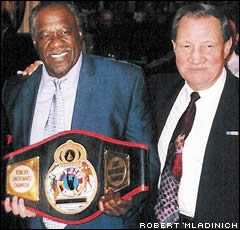Johnny Persol Finally Gets His Belt
 Johnny Persol displays the Uncrowned Light-Heavyweight Championship belt that was presented to him by the RING 8 Veteran Boxers Association in New York City on December 19, 2004/
Johnny Persol displays the Uncrowned Light-Heavyweight Championship belt that was presented to him by the RING 8 Veteran Boxers Association in New York City on December 19, 2004/
When the Ring 8 Veteran Boxers Association in New York City honored Johnny Persol with an Uncrowned Light-Heavyweight Championship Belt at its annual Christmas luncheon on December 19, the 64-year-old former contender whose shoulders are as wide as his smile is large and welcoming, could barely contain his joy. He shook countless hands, accepted numerous accolades, and laughed and cried with equal intensity. The always vibrant and upbeat Persol, who is quick to point out that he has had a most rewarding and enjoyable life, said that day might have been one of his happiest of all.
“It was fantastic,” he proclaimed. “Getting that award was like being born again. Being in the same room with so many boxing people, people who were so important to me, brought back a lot of memories. I’ve been retired since 1969, and it was great to have people remember me and say, ‘Yeah, he could fight a little bit.’” Among the hundreds in attendance were Persol’s former trainer Gil Clancy, manager Howie Albert, fellow honorees Chuck Wepner and Vinny Paz, and Mike Silver, who is one of the official historians for Ring 8.
According to Silver, who has been fastidiously following boxing for more than 40 years, Persol’s assessment of himself is a gross understatement. He says Persol could do so much more than just fight a little bit. “From an aesthetic standpoint, there were very few boxers more pleasurable to watch,” said Silver. “He was a pure boxer, with a capital B. His speed, footwork and jabs had a ballet-like quality about them. He was born to box, born to be a champion. Unfortunately that never happened. He was too good too soon, and was fighting much more experienced fighters in main events at Madison Square Garden by his ninth pro fight.”
Persol campaigned as a professional from 1963-69, and was forced to retire after incurring a serious eye injury. But his final record of 22-5-1 (7 KOs) doesn’t begin to explain what a compelling fighter he really was. Growing up in the small town of New Bern, North Carolina, he remembers the entire town shutting down when Joe Louis and Sugar Ray Robinson fought. He was awestruck by the effect those great champions had on his small community, and entertained the idea of becoming an amateur boxer. However, there were no pugilistic options available in New Bern. The only boxer he knew personally was a local man who boxed on the U.S. Army team and would teach eager youngsters the rudiments of hooking and jabbing on the rare occasions that he was home on leave.
In 1958, at the age of 18, Persol set out for Brooklyn, New York, with two ambitions: to get a job and to become a boxer. Within weeks he began working at a lingerie factory by day and took up boxing at the Bedford-Stuyvesant PAL at night. Although Persol had no experience, his trainer there, Ham Willoughby, knew that Persol was special the minute he laid eyes on him. Within months, Persol became a novice PAL champion and over the next few years won several Golden Gloves titles and the Eastern and National Championships. Thinking he had accomplished all that he set out to, Persol, who was undefeated in 85 fights, sat out 1962.
He had no plans to turn pro, but after seeing so many fighters he had already beaten making a living by boxing professionally in the vibrant New York scene, he turned pro at Madison Square Garden in January 1963. His opponent was Don Turner, a veteran of seven fights who would later gain renown as the trainer of several world champions, including Evander Holyfield.
“He was really awkward, hard to hit, a Roy Jones-Pernell Whitaker type,” recounts Persol. “I won the decision, but it was an ugly fight and I felt miserable. But everyone said I did great, that I beat a good fighter in my pro debut.”
In his ninth fight, which he accepted on just a few days notice, Persol took on Allen Thomas, who was 20-2-1, at the Garden. Persol says matchmaker Teddy Brenner told Clancy that he was crazy to put his 23-year-old protégé in with such a hot prospect, but Clancy, at Persol’s urging, convinced Brenner to do so. Persol outpointed Thomas before a packed crowd and was on his way. In his next fight, again at the Garden, Persol survived a sixth round knockdown to beat the formidable Eddie Cotton, who was 50-14-1. However, a month later he was stopped in four rounds in a rematch with the tricky veteran, which caused some people to believe he was being moved too quickly.
“It was the last years of a television era,” Silver said, “and television was desperate for fights. Persol was made for television. But I always thought that he should never have been put back in with Cotton so soon after beating him. Cotton was old school, and knew all the tricks. He was savvy enough to figure out the young guy’s style and beat him the second time around.”
Persol vehemently discounts any assertions that he was mismanaged, and said it was he who insisted on fighting the best fighters available. He came down with a cold just prior to the Cotton rematch, and says Clancy pleaded with him to pull out. Persol wouldn’t hear of it. “I think I was making $42 a week, and the fight paid $8,000 or $10,000. I was a fighter, so it never occurred to me not to fight. That was my livelihood. Sometimes you had to go to work sick, so it was no different than going in the ring a little sick. I took great pride in what I did. I learned how to fight on the job, by fighting the best guys out there, so I thought nothing of it. I feel as if my career was managed just fine.”
Three months after suffering his first loss, to Cotton, Persol beat former champion Carl “Bobo” Olson” by decision, again at the Garden where he was by now a house favorite. After a draw with the durable Henry Hank, Persol traveled to Montana, where he was stopped in one round by Roger Rouse, who former light heavyweight champion Bob Foster once said hit him the hardest of anyone he ever fought – Muhammad Ali and Joe Frazier included. Persol says Rouse blasted him with a right hand that caused immediate unbearable pain in his left eye. Persol was taken to a local hospital, where he says a doctor told him to take a few months off and all would be fine. Little did he know at the time, said Persol, he had severely damaged his orbital bone, an injury that would be a portent of worse things to come.
Returning to the ring five months later, Persol outpointed another beautiful boxer in Harold Johnson, and then went after the bigger money in the heavyweight division. “I learned more from my fight with Johnson than I learned in all of my years in the gym,” said Persol. “He was cagey, and that fight really brought me into my own. I’m very proud of beating Johnson. He was a tough, tough guy to beat. After beating him, I thought I could beat anybody.”
Now campaigning as a heavyweight, he outpointed the previously undefeated James J. Woody and veteran Amos “Big Train” Lincoln. Then he was shockingly stopped in one round by future champion Jimmy Ellis on the undercard of Muhammad-Ali-Zora Folley in March 1967. “Jimmy Ellis was the biggest fight of my life,” asserts Persol. “That was around the time they were going to strip Muhammad Ali of his title [for draft evasion] and have a tournament to find a new champion. I trained to the best of my ability, and was warming up in the dressing room when they told me I was about to go on. Then we got held up about ten minutes and I got cold. I suddenly felt flat. It wasn’t nerves, because I wasn’t afraid of him. I knew something was wrong, but I kept telling myself, ‘you’re a fighter, you’ve got to fight.’ The bell rings and I’m ready to roll. Then, bam, I’m down! Bang, I’m down again and the fight’s over. It was a helluva setback.”
Persol is refreshingly candid when discussing his career, and never makes excuses for his misfortunes or aggrandizes his successes. But, he concedes, “Looking back, I honestly believe I beat myself in all the fights I lost. Something didn’t click, something wasn’t right. I wish I had an excuse, but I don’t believe in them. In life, you take the good with the bad, and in the end you hope it all sorts out.”
A few fights later, in March 1968, Persol suffered a detached retina in a Garden bout with unheralded Angel Oquendo. It was then, he says, that the severity of the earlier damage done by Rouse was discovered. Persol became one of the first boxers ever to undergo newly discovered laser treatment, and fought twice more. But the damage to his left eye was more than minimal, and with perpetually blurred and hazy vision he lost much of his defensive and offensive arsenal. In his last fight, he was stopped in seven by Jimmy Dupree, whom he had already beaten four years earlier.
Thirty-six years ago Persol went to work as a longshoreman and eventually became a shop steward, a position he holds to this day. Although he is eligible for Social Security, the divorced father of five grown children has no plans of retiring. A resident of Elizabeth, New Jersey, he loves training young amateurs and pros several nights a week at the Lopez Boxing Club in Newark. His star pupil, 20-year-old super featherweight Mike Torres, 3-0 (1 KO), has been with him since he was 13, and is scheduled to lace them up at the Foxwoods Casino in Connecticut on November 4.
“I see a lot of me in him,” said Persol, whose training partner for the last 14 years has been Juan Lopez. “Sometimes it’s kind of frightening. Mike is a good kid with a great future ahead of him. I never won a title, but I consider myself a very lucky man. I hope Mike wins a title, and I’m pretty certain he will. But even if he doesn’t, if he has as good a life as I’ve had, he’ll be a success.”
Posted under Articles


